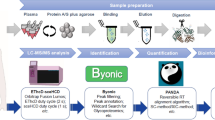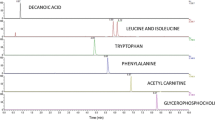Abstract
Urine adulteration to circumvent positive drug testing represents a problem for toxicological laboratories. While creatinine is a suitable marker for dilution, detection of chemicals is often performed by dipstick tests associated with high rates of false positives. Several methods would be necessary to check for all possible adulterants. Untargeted mass spectrometry (MS) methods used in metabolomics should theoretically allow detecting concentration changes of any endogenous urinary metabolite or presence of new biomarkers produced by chemical adulteration. As a proof of concept study, urine samples from 10 volunteers were treated with KNO2 and analyzed by high-resolution MS. For statistical data evaluation, XCMSplus and MetaboAnalyst were used. Compound identification was performed by database searches using an in-house database, Chemspider, METLIN, HMDB, and NIST. Principle component analysis revealed clear separation between treated and untreated urine samples. In detail, 307 features showed significant concentration changes with fold changes greater than 2 (79 decreased; 228 increased). Mainly amino acids (e.g., histidine, methylhistidine, di- and trimethyllysine) and purines (uric acid) were detected in lower amounts. 5-HO-isourate was found to be formed as a new compound from uric acid and, e.g., imidazole lactate concentrations increased due to the breakdown of histidine. This metabolomics-based strategy allowed for a broad identification range of markers of urinary adulteration. More studies will be needed to investigate routine applicability of identified potential markers exploring urinary conditions of their formation and stability. Selected markers might then be integrated into routine MS screening procedures allowing for detection of adulteration within routine MS analysis.

ᅟ




Similar content being viewed by others
References
Phan HM, Yoshizuka K, Murry DJ, Perry PJ. Drug testing in the workplace. Pharmacotherapy. 2012;32(7):649–56.
Verstraete AG. Detection times of drugs of abuse in blood, urine, and oral fluid. Ther Drug Monit. 2004;26(2):200–5.
Fu S, Luong S, Pham A, Charlton N, Kuzhiumparambil U. Bioanalysis of urine samples after manipulation by oxidizing chemicals: technical considerations. Bioanalysis. 2014;6(11):1543–61.
Maurer HH. Analytical toxicology. EXS. 2010;100:317–37.
Maurer HH. Current role of liquid chromatography-mass spectrometry in clinical and forensic toxicology. Anal Bioanal Chem. 2007;388(7):1315–25.
Maurer HH. What is the future of (ultra) high performance liquid chromatography coupled to low and high resolution mass spectrometry for toxicological drug screening? J Chromatogr A. 2013;1292:19–24.
Dresen S, Ferreiros N, Gnann H, Zimmermann R, Weinmann W. Detection and identification of 700 drugs by multi-target screening with a 3200 Q TRAP LC-MS/MS system and library searching. Anal Bioanal Chem. 2010;396(7):2425–34.
Peters FT. Recent advances of liquid chromatography-(tandem) mass spectrometry in clinical and forensic toxicology. Clin Biochem. 2011;44(1):54–65.
Wu AHB, Bristol B, Sexton K, Cassella-McLane G, Holtman V, Hill DW. Adulteration of urine by "urine luck". Clin Chem. 1999;45(7):1051–7.
Uebel RA, Wium CA. Toxicological screening for drugs of abuse in samples adulterated with household chemicals. S Afr Med J. 2002;92(7):547–9.
Jaffee WB, Trucco E, Levy S, Weiss RD. Is this urine really negative? A systematic review of tampering methods in urine drug screening and testing. J Subst Abus Treat. 2007;33(1):33–42.
Valtier S, Cody JT. A procedure for the detection of stealth adulterant in urine samples. Clin Lab Sci. 2002;15(2):111–5.
Peace MR, Tarnai LD. Performance evaluation of three on-site adulterant detection devices for urine specimens. J Anal Toxicol. 2002;26(7):464–70.
Dasgupta A, Chughtai O, Hannah C, Davis B, Wells A. Comparison of spot tests with Adulta Check 6 and Intect 7 urine test strips for detecting the presence of adulterants in urine specimens. Clin Chim Acta. 2004;348(1–2):19–25.
Paul BD, Martin KK, Maguilo J Jr, Smith ML. Effects of pyridinium chlorochromate adulterant (urine luck) on testing for drugs of abuse and a method for quantitative detection of chromium (VI) in urine. J Anal Toxicol. 2000;24(4):233–7.
Dasgupta A. The effects of adulterants and selected ingested compounds on drugs-of-abuse testing in urine. Am J Clin Pathol. 2007;128(3):491–503.
Edwards C, Fyfe MJ, Liu RH, Walia AS. Evaluation of common urine specimen adulteration indicators. J Anal Toxicol. 1993;17(4):251–2.
Luong S, Fu S. Detection and identification of 2-nitro-morphine and 2-nitro-morphine-6-glucuronide in nitrite adulterated urine specimens containing morphine and its glucuronides. Drug Test Anal. 2014;6(3):277–87.
Luong S, Shimmon R, Hook J, Fu S. 2-Nitro-6-monoacetylmorphine: potential marker for monitoring the presence of 6-monoacetylmorphine in urine adulterated with potassium nitrite. Anal Bioanal Chem. 2012;403(7):2057–63.
Lewis SA Sr, Lewis LA, Tuinman A. Potassium nitrite reaction with 11-nor-delta 9-tetrahydrocannabinol-9-carboxylic acid in urine in relation to the drug screening analysis. J Forensic Sci. 1999;44(5):951–5.
Dinis-Oliveira RJ. Metabolomics of drugs of abuse: a more realistic view of the toxicological complexity. Bioanalysis. 2014;6(23):3155–9.
Dettmer K, Aronov PA, Hammock BD. Mass spectrometry-based metabolomics. Mass Spectrom Rev. 2007;26(1):51–78.
Nicholson JK, Lindon JC, Holmes E. 'Metabonomics': understanding the metabolic responses of living systems to pathophysiological stimuli via multivariate statistical analysis of biological NMR spectroscopic data. Xenobiotica. 1999;29(11):1181–9.
Xia J, Wishart DS. Using Metabo analyst 3.0 for comprehensive metabolomics data analysis. Current protocols in. Bioinformatics. 2016;55:14 10 11–91.
Urry FM, Komaromy-Hiller G, Staley B, Crockett DK, Kushnir M, Nelson G, et al. Nitrite adulteration of workplace urine drug-testing specimens I. Sources and associated concentrations of nitrite in urine and distinction between natural sources and adulteration. J Anal Toxicol. 1998;22(2):89–95.
Paul BD, Jacobs A. Effects of oxidizing adulterants on detection of 11-nor-delta9-THC-9-carboxylic acid in urine. J Anal Toxicol. 2002;26(7):460–3.
Barri T, Dragsted LO. UPLC-ESI-QTOF/MS and multivariate data analysis for blood plasma and serum metabolomics: effect of experimental artefacts and anticoagulant. Anal Chim Acta. 2013;768:118–28.
Yang Y, Cruickshank C, Armstrong M, Mahaffey S, Reisdorph R, Reisdorph N. New sample preparation approach for mass spectrometry-based profiling of plasma results in improved coverage of metabolome. J Chromatogr A. 2013;1300:217–26.
Benton HP, Ivanisevic J, Mahieu NG, Kurczy ME, Johnson CH, Franco L, et al. Autonomous metabolomics for rapid metabolite identification in global profiling. Anal Chem. 2015;87(2):884–91.
Bouatra S, Aziat F, Mandal R, Guo AC, Wilson MR, Knox C, et al. The human urine metabolome. PLoS One. 2013;8(9):e73076.
Zydron M, Baranowski J, Baranowska I. Separation, pre-concentration, and HPLC analysis of methylxanthines in urine samples. J Sep Sci. 2004;27(14):1166–72.
Kakimoto Y, Akazawa S. Isolation and identification of N-G,N-G- and N-GN'-G-dimethyl-arginine, N-epsilon-mono-, di-, and trimethyllysine, and glucosylgalactosyl- and galactosyl-delta-hydroxylysine from human urine. J Biol Chem. 1970;245(21):5751–8.
Kim KM, Henderson GN, Frye RF, Galloway CD, Brown NJ, Segal MS, et al. Simultaneous determination of uric acid metabolites allantoin, 6-aminouracil, and triuret in human urine using liquid chromatography-mass spectrometry. J Chromatogr B Analyt Technol Biomed Life Sci. 2009;877(1–2):65–70.
West Cadwell NJ. Geigy scientific tables, Medical education div vol 1, vol. vol 29. 8th ed. Basel, Switzerland: Ciba-Geigy Corp.
McMillan A, Renaud JB, Gloor GB, Reid G, Sumarah MW. Post-acquisition filtering of salt cluster artefacts for LC-MS based human metabolomic studies. J Cheminform. 2016;8(1):44.
Grimsrud PA, Xie H, Griffin TJ, Bernlohr DA. Oxidative stress and covalent modification of protein with bioactive aldehydes. J Biol Chem. 2008;283(32):21837–41.
Maples KR, Mason RP. Free radical metabolite of uric acid. J Biol Chem. 1988;263(4):1709–12.
Gomez-Ruiz JA, Leake DS, Ames JM. In vitro antioxidant activity of coffee compounds and their metabolites. J Agric Food Chem. 2007;55(17):6962–9.
Leon-Carmona JR, Galano A. Uric and 1-methyluric acids: metabolic wastes or antiradical protectors? J Phys Chem B. 2011;115(51):15430–8.
Pipolo S, Percudani R, Cammi R. Absolute stereochemistry and preferred conformations of urate degradation intermediates from computed and experimental circular dichroism spectra. Org Biomol Chem. 2011;9(14):5149–55.
Tsai LS, ElSohly MA, Tsai SF, Murphy TP, Twarowska B, Salamone SJ. Investigation of nitrite adulteration on the immunoassay and GC-MS analysis of cannabinoids in urine specimens. J Anal Toxicol. 2000;24(8):708–14.
Acknowledgements
The authors would like to thank Lana Brockbals, Dr. Markus R. Baumgartner, and Dr. Christian Steuer for helpful discussions and express their gratitude to Emma Louise Kessler, MD for her generous legacy she donated to the Institute of Forensic Medicine at the University of Zurich, Switzerland for research purposes.
Author information
Authors and Affiliations
Corresponding author
Ethics declarations
Conflict of interest
None.
Human and animal rights and informed consent
Authentic human urine samples were collected and analyzed anonymously from ten different healthy volunteers who provided written informed consent. According to Swissethics (Humanforschungsgesetz), no further ethical approval from the cantonal ethic commission is necessary if the research is not aiming to investigate diseases or functions of the human body as has been the case in the current study.
Electronic supplementary material
ESM 1
(DOCX 264 kb)
Rights and permissions
About this article
Cite this article
Steuer, A.E., Arnold, K., Schneider, T.D. et al. A new metabolomics-based strategy for identification of endogenous markers of urine adulteration attempts exemplified for potassium nitrite. Anal Bioanal Chem 409, 6235–6244 (2017). https://doi.org/10.1007/s00216-017-0567-4
Received:
Revised:
Accepted:
Published:
Issue Date:
DOI: https://doi.org/10.1007/s00216-017-0567-4




